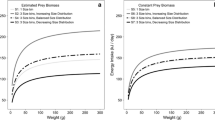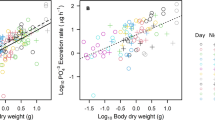Abstract:
Physiological data indicate that a 3-compartment model appropriately represents ingestion, assimilation, and accumulation of somatic and reproductive tissue by an aquatic invertebrate predator. A secondary production model calibrated to growth and respiration data is used to constrain the model equations. Inverse solution methods are used to estimate rate constants for digestion and for net accrual of tissue by growing animals at different temperatures. Predicted time to 50% maximum digestion matches well with the empirical rate of digestion of prey enzymes in the predator gut. Model-derived digestion rates are consistent with the assimilation rate constant obtained by independent radiotracer methods, and with experimental detection time for prey enzymes. The model approach permits parameter estimation within a complex system of equations so that results can be compared with experimental data.
Similar content being viewed by others
Author information
Authors and Affiliations
Additional information
Received 25 May 1999; revised manuscript accepted 11 October 2000.
Rights and permissions
About this article
Cite this article
Lehmann, J., Foy, R. & Lehman, D. Inverse model method for estimating assimilation by aquatic invertebrates. Aquat. sci. 63, 168–181 (2001). https://doi.org/10.1007/PL00001349
Issue Date:
DOI: https://doi.org/10.1007/PL00001349




